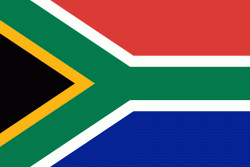Midrand
Midrand is a former municipality in central Gauteng, South Africa. Situated in-between Centurion and Sandton, Midrand now forms part of the City of Johannesburg Metropolitan Municipality.
Midrand was established as a municipality in 1981 (in an area known as Halfway House, after its position between Pretoria and Johannesburg), but ceased to be an independent town in the restructuring of local government that followed the end of apartheid in 1994. It was incorporated in the City of Johannesburg Metropolitan Municipality in 2000. It was made part of Region 2 and, as of 2006, when the number of regions were reduced to seven, it forms part of Region A of the City of Johannesburg.
Though no longer an independent town, the name Midrand is still in common use to denote the suburbs around the N1 highway north of the Jukskei River up to the border with City of Tshwane Metropolitan Municipality. (This portion of the N1 highway is also known as the Ben Schoeman Highway). Suburbs that are generally regarded as being in Midrand include among others: Country View, Carlswald, Crowthorne, Glen Austin, Ivory Park, Halfway House, Halfway Gardens, Vorna Valley, Noordwyk, Randjesfontein, Blue Hills and Kyalami Agricultural Holdings.
In 2010, it was reported that the Tshwane Metropolitan Municipality wished to annex Midrand from the City of Johannesburg, reportedly to boost its income, which was severely strained.
The city is relatively modern, having experienced much growth in the last decade. Many businesses have relocated there due to its proximity to good highway links and its location in the economic centre of Gauteng Province. The development of Midrand has resulted in little break between the outskirts of Johannesburg and those of Pretoria.
Townships can be found in Midrand such as Klipfontein view and Ivory Park.
Midrand was established as a municipality in 1981 (in an area known as Halfway House, after its position between Pretoria and Johannesburg), but ceased to be an independent town in the restructuring of local government that followed the end of apartheid in 1994. It was incorporated in the City of Johannesburg Metropolitan Municipality in 2000. It was made part of Region 2 and, as of 2006, when the number of regions were reduced to seven, it forms part of Region A of the City of Johannesburg.
Though no longer an independent town, the name Midrand is still in common use to denote the suburbs around the N1 highway north of the Jukskei River up to the border with City of Tshwane Metropolitan Municipality. (This portion of the N1 highway is also known as the Ben Schoeman Highway). Suburbs that are generally regarded as being in Midrand include among others: Country View, Carlswald, Crowthorne, Glen Austin, Ivory Park, Halfway House, Halfway Gardens, Vorna Valley, Noordwyk, Randjesfontein, Blue Hills and Kyalami Agricultural Holdings.
In 2010, it was reported that the Tshwane Metropolitan Municipality wished to annex Midrand from the City of Johannesburg, reportedly to boost its income, which was severely strained.
The city is relatively modern, having experienced much growth in the last decade. Many businesses have relocated there due to its proximity to good highway links and its location in the economic centre of Gauteng Province. The development of Midrand has resulted in little break between the outskirts of Johannesburg and those of Pretoria.
Townships can be found in Midrand such as Klipfontein view and Ivory Park.
Map - Midrand
Map
Country - South_Africa
 |
 |
| Flag of South Africa | |
About 80% of the population are Black South Africans. The remaining population consists of Africa's largest communities of European (White South Africans), Asian (Indian South Africans and Chinese South Africans), and multiracial (Coloured South Africans) ancestry. South Africa is a multiethnic society encompassing a wide variety of cultures, languages, and religions. Its pluralistic makeup is reflected in the constitution's recognition of 11 official languages, the fourth-highest number in the world. According to the 2011 census, the two most spoken first languages are Zulu (22.7%) and Xhosa (16.0%). The two next ones are of European origin: Afrikaans (13.5%) developed from Dutch and serves as the first language of most Coloured and White South Africans; English (9.6%) reflects the legacy of British colonialism and is commonly used in public and commercial life.
Currency / Language
| ISO | Currency | Symbol | Significant figures |
|---|---|---|---|
| ZAR | South African rand | Rs | 2 |
| ISO | Language |
|---|---|
| AF | Afrikaans language |
| EN | English language |
| ST | Sotho language |
| SS | Swati language |
| TS | Tsonga language |
| TN | Tswana language |
| VE | Venda language |
| XH | Xhosa language |
| ZU | Zulu language |















